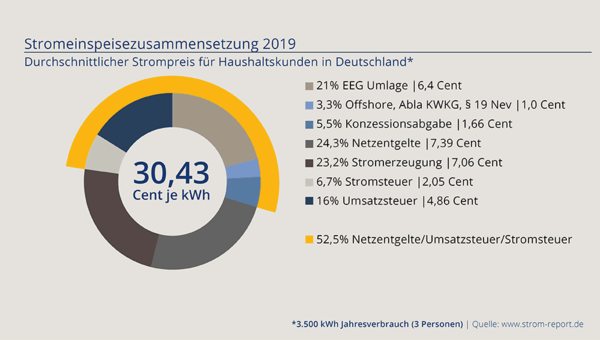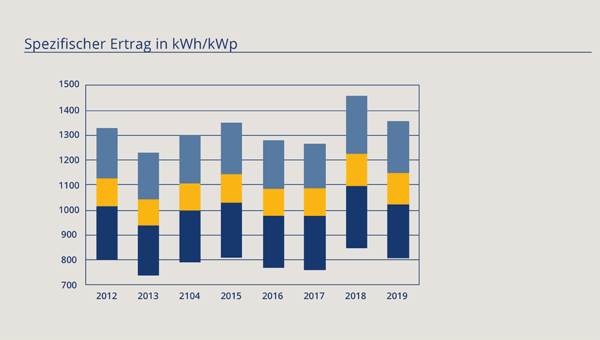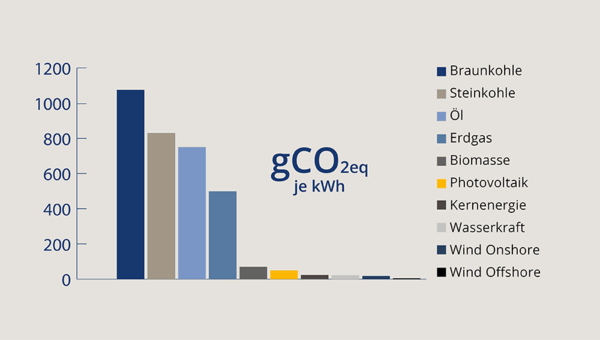PV Energy - Yes, Please!
by Vivian Bullinger | 27.02.2020
 Climate change, energy transition, coal phase-out, nuclear phase-out, feed-in tariff, EEG levy... These are all terms that come to mind around renewable energies. In a short fact check, we want to take a closer look at the most common questions regarding the effectiveness, costs, efficiency and environmental friendliness of PV energy.
Climate change, energy transition, coal phase-out, nuclear phase-out, feed-in tariff, EEG levy... These are all terms that come to mind around renewable energies. In a short fact check, we want to take a closer look at the most common questions regarding the effectiveness, costs, efficiency and environmental friendliness of PV energy.
Are the PV energy and the renewable energies effective?
Does the PV Energy Contribute something to the Power Supply?
And how! In total, PV energy contributed about 8.2% to gross electricity consumption in 2019. This means it has more than doubled its share in just a few years. All renewables combined, electricity generation was 43%. PV energy is increasingly important and will - as of today - form the backbone of the sustainable energy future.
Is PV Energy a German Phenomenon?
No. We can certainly claim to be a pioneer in some areas of PV energy, but PV energy is now used worldwide. In 2019, 1.7 million PV systems with a capacity of 49 GW were installed in Germany. Worldwide, an addition of 115 GW was achieved in the same year. China has been the frontrunner here for years, followed by the USA, Japan, and Germany.
Economic Aspects of the PV Industry
The German PV industry is under strong pressure, especially from the Chinese PV industry. Nevertheless, the PV industry employs about 24000 people in Germany in 2018 [BSW]. Many of these jobs are created by inverter manufacturers and installation companies. In addition, intelligent solutions for controlling and monitoring PV systems or their yields are always in demand. Medium-sized companies, such as the Solar Data Systems GmbH, have specialized in these areas and offer intelligent solutions here for the international market.
What does PV Energy Cost Us?
PV Energy causes Costs - Keyword EEG Apportionment?
For many it is a red rag when they see and have to pay the EEG levy on their electricity bill. The reputation of this levy is bad and some people think that they are paying for their neighbor's PV system. The fact is that the EEG levy supports the expansion of renewable energies. Without it, this expansion would hardly be feasible at present.
What is the Composition of the Levy?
Anyone who feeds electricity from renewable energies into the public grid receives the so-called feed-in tariff. The transmission system operators then trade this electricity on the electricity exchange. There, the "green" electricity competes with coal and nuclear power. The prices on the exchange are lower than the legally fixed compensation rates. This difference is then compensated with the EEG levy.

Does every electricity consumer pay the EEG levy?
No. So-called electricity-intensive companies are exempt from the levy. This means that those who consume the most do not have any additional costs due to the levy. In addition, PV electricity benefits because it causes a low electricity price on the stock exchange at peak load times, which means that companies can purchase electricity cheaply.
Is the EEG levy a subsidy?
No. The EEG levy is necessary to finance the feed-in tariff and thus the expansion of renewable energies. It is not a subsidy - and this in contrast to fossil and nuclear power generation, which receive subsidies from the state. (Read more in a study by Greenpeace "Study: "Subsidies for fossil energies in Germany" from 2017.)
What subsidy programs are available for the use of renewable energies?
In addition to the feed-in tariff, there are numerous other programs designed to promote the expansion of renewable energies.
Is nuclear energy cheap?
True only if one would not have to dispose of the resulting nuclear waste and if nothing happens. The nuclear disaster in Fukushima cost well over €100 billion in financial terms alone. Not to mention the human tragedies that were and are associated with it. (Source: https://www.iwr.de) If you are interested in the accidents and the costs of the last decades, you will find on the Tagesschau.de page a clear listing.
To date, no solution has yet been found for "disposing" of nuclear power. The word final disposal is misleading. There is virtually no definitive way to dispose of nuclear waste or render it harmless. In Germany, meanwhile, the federal states are arguing about where a "suitable" place for storage is. A site is to be found by 2031. Right now, more and more people are calling for new nuclear power plants in order to achieve the climate targets. However, we should not lose sight of the dangers associated with nuclear energy and the fact that there are alternatives.
Is a PV system still financially worthwhile?
From a purely financial point of view, one has to weigh up. The return on investment of a PV system depends on many factors and must be analyzed carefully in each individual case. Although the remuneration has been reduced considerably, the prices for a PV system have also dropped drastically. In addition, there are attractive subsidy options, such as the KfW loans.
Using PV Electricity Directly: Self-Consumption
In addition, the possible uses of PV electricity have greatly expanded in recent years (link last blog article) especially in the area of self-consumption. Those who consume the electricity directly save with every kW/h the purchase of electricity and thus also make themselves a good deal more independent of future electricity price increases.
For example: let's take a four-person household that consumes 4500 kilowatt hours of electricity per year and has a PV system with 5 kWp on the roof. With the system, this household can generate one third, or about 1500 kWh, of its electricity consumption itself in the year. At an average electricity price of 30.85 ct/kWh, this means a saving of around 460 euros per year (or 9,250 euros over a system lifetime of 20 years).
PV System for 0 Euros and Rental Electricity Models
Another aspect: the production costs of "own" solar electricity are about half of what electricity from the energy company costs. For those who, as a private household or in an apartment building, do not have the money/opportunity to purchase a PV system, the so-called PV rental models offer a possible alternative. One variant of the rental power model for private homeowners; rent the PV system on your own roof. For this you need a roof area and a monthly budget that depends on the size of the system (approx. 70 to 180 €). With this payment all costs like insurances and monitoring are covered. This monthly payment runs for 20 years, after which the plant becomes the property of the tenant. Usually the tenant can buy the plant at any time at the current market value. An example to "PV plant for 0 €" of the company Solera.

Are PV systems efficient?
How efficient are PV plants in Germany?
To calculate this, there is a measurement index, the so-called PR value (Performance Ratio). The PR value is the ratio between the maximum achievable yield and the actual PV energy generated. The efficiency of a plant can be read from the value. The higher the percentage of the PR value, the more efficient the PV system is. (More about this under: https://www.photovoltaik.org)
A new PV system in Germany achieves a PR value of 80 - 90 % (Source: https://www.ise.fraunhofer.de). Another metric is the specific yield. The specific amount is calculated from the ratio of the electricity yield kWh in relation to the installed power kWp. Last year, a good average was 1100 kWh/kWp and max ca 1350 kWh/kWp. For comparison: in southern Spain or North Africa specific yields up to 1600 kWh/kWp can be achieved.
Figure: Specific annual yields of rooftop photovoltaic systems in Germany for the period 2012 to 2019. The bars indicate the ranges in which the specific yields of good photovoltaic systems should lie in the individual years. (Source ISE Frauenhofer Institut- Stuide: Current facts on photovoltaics).
Efficiency of PV Modules
Another factor in yields is module output. The more power a module produces, i.e. converts sunlight into electricity, the better the efficiency. Efficiencies of up to 24.58 percent are now being achieved. As a result, the prices of the modules continue to fall indirectly.
Cell Type and Efficiency
Monocrystalline 20 - 22 %, polycrystalline 15 - 20 %, amorphous silicon 8 %, CIS cells 12 %, GaAS cells 25 %, and dye cells 2 - 3 %.

Are PV systems environmentally friendly?
Do PV systems make an effective contribution to reducing CO2 emissions?
A PV system does not produce CO2 while it is generating electricity. To obtain a comparable value, one must include the CO2 emissions during production and disposal.
Average CO2-equivalent emissions of different power generation technologies (source ISE Frauenhofer Institut- Stuide: Current facts about photovoltaics).
For an insight into the global CO2 emissions generated by power generation (gCO2eq/kWh), see: https://app.electricitymaps.com/map
Does PV energy reduce CO2 emissions?
Last year (2019), CO2 emissions were reduced by 44 percent compared to 1990. The largest factor in this was the reduction of coal-fired power plants by around 25% compared to 2018. In addition, the expansion of renewable energy, which saw a 9% growth in 2019, contributes to a healthier environment. (Source BDEW)
Conclusion
These figures show that the path is the right one, but the goal is far from being reached. PV energy makes an important contribution to reducing CO2. PV energy makes a relevant and steadily growing contribution to electricity supply. Moreover, PV energy efficiently provides electricity for general energy supply. Nevertheless, there is still a long way to go. To achieve the climate protection goals of the German government, a continuous expansion of renewable energies is necessary. This cannot be achieved without costs for the general public. At the same time, we must never lose sight of the fact that ultimately it is the general public that benefits most from an effective climate policy.
Back to the overview




